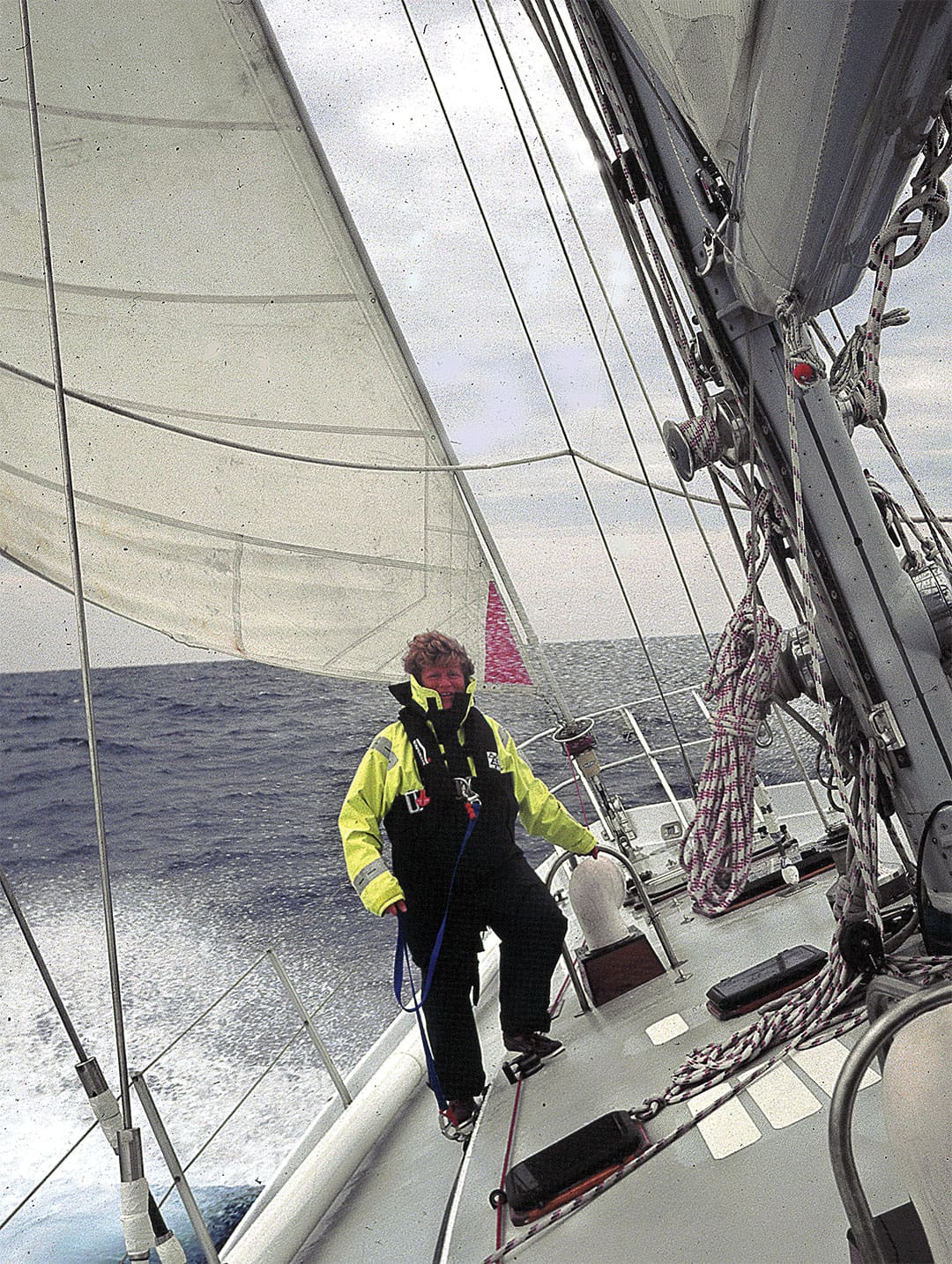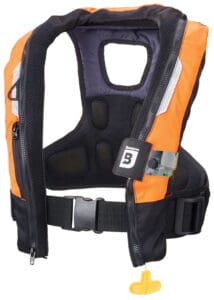
Whether your next voyage takes you across an ocean or just across your local harbor, the possibility of crew or guests falling overboard is an ever-present concern. In decades past, we hung thick, orange, uncomfortable foam blocks from our necks for the entire time we were out on deck. Now those days are gone, thanks to updated designs and superior materials. With the wide array of compact, ergonomic, auto-inflatable personal flotation devices (PFDs) on the market, we can be both safe and comfortable while under sail.
Before we invest in a set of auto-inflate PFDs for our vessels, we need to understand how these devices work, along with the various grades of these vital pieces of equipment, depending on their rating under the International Organization for Standardization (ISO) or U.S. Coast Guard, each of which has its own required specifications for auto-inflatable units. Whatever your choice of flotation device, assuming you are traveling on your own yacht without paying passengers, the PFDs you purchase from your local chandler will almost certainly meet minimum USCG requirements.
USCG requirements
Our first step in selecting the right PFDs for our yachts is to understand what the USCG requires for these devices on coastal and offshore recreational vessels. The Coast Guard is currently rewriting its rules, so its website is rather vague at this moment about what exactly they require for inland, coastal and U.S.-flagged offshore vessels. However, the following is a list of PFD descriptions generally agreed upon within the U.S. boating community.
Type 1: Large, bulky, foam-filled, wrap-around vests with 22 pounds of buoyancy, which is enough to keep the average wearer’s head safely above water level.
Type 2: The standard, orange, wearable box-shaped devices with one strap around the wearer’s back. It provides 15.5 pounds buoyancy and fulfills USCG requirements. However, in all of my years of sailing, I have yet to see even one crewmember or guest on any vessel wear one of these uncomfortable PFDs.
Legacy Type 3 (Level 70): Buoyant, inflatable or hybrid designs. This type is being eliminated by the USCG and integrated into the other four PFD classifications.
Type 4: This is a throwable device for boats 16 feet or longer. At least one throwable, usually a yellow, foam-filled horseshoe PFD, is required on all vessels. Also, it must be “immediately available” to fulfill USCG requirements. Most of us cruisers mount the yellow horseshoe on the stern pulpit, the closest point to a crew member who has the misfortune of falling in the water. Floating seat cushions are also included under this category.

Type 5: The highest-quality PFD in the lineup, this is an auto-inflatable vest with a strong strap harness and a stainless steel buckle for offshore use. This PFD must be worn while underway to meet USCG requirements.
How they work
Early PFD models, such as those before the 2000s, were almost always manually activated and packaged in heavy, dark blue polyester canvas, which is highly resistant to sun damage. Most of these PFDs also included a rubber tube a crew member could fill up orally in case of loss of pressure in the PFD gland or failure of the CO2 canister.
Today’s auto-inflate PFDs operate much more rapidly and efficiently than earlier models. When the sensor detects the presence of water, it automatically activates a spring-loaded pin, which in turn punctures the metallic seal inside the threaded throat of the CO2 canister. Within seconds, the CO2 canister inflates the rubber bladder that lines the interior of the canvas cover, keeping the crewmember’s head above water. And just as with older models of PFDs, if the bladder eventually loses CO2 compression, the user can make use of the rubber tube provided for oral inflation.
If you are concerned about the dark blue canvas not being visible to aircraft, you have nothing to fear. The inflatable bladder wrapped securely under the cover is brightly colored in lime green, orange or yellow so it can be seen from a great distance, whether by a passing ship or a search aircraft crossing overhead.

bottle and
inflation mechanism.
Gas cartridges
A variety of recreational devices use metal CO2 tubes to provide high pressure, including pellet and paintball guns, beer kegs, lightweight bicycle tire pumps and any number of other devices.

The standard PFD CO2 cartridge is composed of a saltwater-resistant steel alloy and features a screw connector, as opposed to the smooth connectors usually found in pressurized liquid dispensers and air guns. The CO2 cartridge in your auto-inflate PFD must meet manufacturer and USCG requirements for compatibility in terms of both the quality of metal casing and type of connector employed.
Several manufacturers, such as Onyx, Eyson, Mustang and Halkey-Roberts, offer replacement CO2 cylinders for roughly $20. The Halkey-Roberts V90000 Rearming Kit, available at West Marine and other chandleries, features one 24-gram CO2 cylinder with a bright green pin and a standard 3/8-inch threaded neck for easy mounting in the inlet port.
Selecting an auto-inflatable PFD
When shopping around for the right set of auto-inflatable PFDs for your vessel, you may be tempted to save a few bucks and settle for an inexpensive inshore design. But remember, once you are out on open water, it doesn’t matter whether you are a mile from the beach or 1,000 miles offshore because you are facing the same aquatic environment with the same inherent risks.
In order to ensure the safety of crew and passengers, buy the best PFDs you can find and make sure you have enough for the maximum number of people expected onboard for the cruise. You can get away with a stack of Type 2 orange PFDs for day sailing in and around your local harbor, but if you venture any farther offshore than that, you need to invest in a set of inflatable PFDs, preferably auto-inflatable, offering the greatest chance of survival for all passengers and crew for several hours. And by the way, if you are trying to save space, auto-inflate PFDs actually take less room than the Type 2 orange boxes.
Mustang Survival USA, one of the well known names in nautical safety, offers an array of PFDs, wet weather apparel and dry suits for both professional and cruising sailors. The Mustang MD3188 Inflatable Work Vest incorporates Hammar Hydrostatic Inflator Technology (HIT), which triggers the CO2 cartridge to fill the internal bladder, or inflation cell, automatically when the HIT system senses four inches of water depth.

Mustang claims its patented pressure-sensitive CO2 trigger system is “maintenance free” for five years from the manufacturing date or until deployed and inflated. In the unlikely event the HIT malfunctions, you can activate the trigger manually.
Another key feature of the MD3188 is its inflatable cell, which is tinted fluorescent yellow green to make the wearer more visible to search vessels and aircraft, offering an even greater chance of being rescued. The MD3188 is rated at 38 pounds of buoyancy after inflation, sufficient for even your largest crew members.
The Mustang HIT system also incorporates a guard against accidental inflation, which could otherwise occur while you are deluged by an errant wave while sitting on deck. Mustang’s patented SecureZip closure system makes sure the vest stays closed, no matter what kind of tough work you may be involved in while up on deck getting doused by heavy seas.
Priced at roughly $200, the MD3188 is quite reasonably priced for this quality of offshore PFD. Mustang USA also makes available an assortment of lower-priced PFDs, so check their list of products before committing yourself to a particular model.
Another popular auto-inflating PFD is the Arcus 40, which is carried on many commercial fishing vessels. Its rugged, wrap-around design and thick foam lend a sturdy, professional appearance to this critically important piece of equipment.
As with most if not all auto-inflate PFDs, the Arcus 40 offers the option of manual inflation with the pull of a yellow tab located at the bottom of the left side of the PFD vest. If you need to inflate the vest orally, you can access the inflation tube by opening the canvas cover, removing the cap and blowing air into the tube until the bladder is firm enough to provide sufficient flotation.
The Arcus 40 provides 40 pounds of buoyancy, roughly twice the buoyancy of an adult-size, throwable foam PFD. This PFD can fit a chest size of 30 to 56 inches, which should cover most sizes of crew. Although the manufacturer describes the Arcus 40 as a Type 2 device, its features more closely resemble those of a Type 5 device, which includes auto-inflatable PFD vests. According to USCG regulations, a true Type 5 vest includes a stainless steel buckle, while vests Type 1-3 usually feature a durable plastic buckle.
West Marine carries its own line of house-brand PFDs, and of all their models, the one most suited to offshore conditions is the A/M All Clear Offshore Inflatable Life Jacket. The cover is composed of a durable synthetic canvas available in red, blue or gray, all of them including iridescent yellow green stripes, which enhances their visibility from distance.

Of all the PFD models you are likely to see, the A/M All Clear from West Marine certainly must have the widest size range, fitting any torso measuring 30 to 65 inches, which covers just about every torso size from Gilligan to The Skipper. A wide neoprene neck ensures a comfortable fit while wearing the PFD for a particularly long watch.
An interesting feature setting this life vest apart from the competition is a viewing window showing whether the unit is properly armed and ready to use. Green indicates it’s ready for deployment, and red indicates it needs to be re-armed.
The trigger system in the A/M All Clear is automatically activated upon sensing the presence of water. Therefore, as with most offshore and professional-grade PFDs, you have the option of converting the inflation system trigger from automatic to manual.
Replacing CO2 cartridges
After activating a CO2 cartridge in an auto-inflating PFD, you will need to replace the cartridge to restore automatic inflation capability. Otherwise, you will need to fill the bladder orally with the mouth tube, if one is provided.
Replacing a CO2 cartridge in an auto-inflatable PFD is an easy, straightforward procedure. First verify the type and size of canister used originally in the PFD. The throat size usually will be either 3/8-inch or 1/2-inch in diameter. Simply unscrew the spent canister from its mounting point and screw in the fresh CO2 cartridge, following the manufacturer’s instructions. Spinlock, Onyx, Mustang and Leland CO2 cartridges are commonly found in chandleries throughout North America.
Even with a complete set of high-quality PFDs for all crew members, every vessel should also have Type I throwable PFDs, which are usually foam rubber squares wrapped in colorful light canvas with straps for grabbing, not wearing. More than one life has been lost by passengers drowning face-down with throwable PFDs strapped to their backs. Always instruct new crew in the use of these devices before leaving the marina — their lives may depend on it. Equip your vessel with high-quality PFDs and sail contentedly, knowing you are doing your best to keep crew and passengers safe from Davy Jones’s Locker.
For further information on safety requirements for inshore and offshore vessels, refer to the USCG’s official site at https://www.dco.uscg.mil/CG-ENG-4/PFDSel/ n
Circumnavigator-author Bill Morris believes the best strategy for succeeding as an offshore voyager is to keep systems simple and, if possible, manual. Key to survival are a windvane self-steering system, an array of electronics and amenities, plus an alternative energy battery charging matrix. Bill is a frequent contributor to Ocean Navigator and the author of The Windvane Self-Steering Handbook (International Marine, 2004); Sun, Wind, & Water: The Essential Guide to the Energy-Efficient Cruising Boat (Seaworthy Publications, 2017), and The Captain’s Guide to Alternative Energy Afloat (Seaworthy Publications, 2019).

